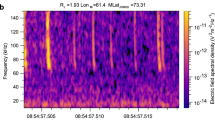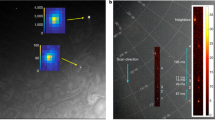Abstract
THE observed ‘cyclic’ variation in the rate of flashing in an active thunderstorm is traced to the fact that a decaying cell can give rise to a new cell and that this process can go on until the thunderstorm itself finally decays1–5. The life of a cell is estimated from direct and indirect experiments to be about 30 min. But no practical method appears to have been devised to estimate the number of cells developed during the entire life-time of a thunderstorm. This communication describes how this useful information can be obtained from investigations of the rates of flashing. Such work requires the recording of all types of flashes, as the relative percentages of the different types of flashes can vary during the life-time of a thunderstorm, and from thunderstorm to thunderstorm. As the lightning-flash counters available at present do not meet this requirement6, a high-frequency counter7 was developed as a prototype of the noise meter previously described8,9.
This is a preview of subscription content, access via your institution
Access options
Subscribe to this journal
Receive 51 print issues and online access
$199.00 per year
only $3.90 per issue
Buy this article
- Purchase on Springer Link
- Instant access to full article PDF
Prices may be subject to local taxes which are calculated during checkout
Similar content being viewed by others
References
Workman, E. J., and Reynolds, S. E., Bull. Amer. Meteor. Soc., 30, 142 (1949).
Workman, E. J., and Reynolds, S. E., Thunderstorm Electricity (Univ. Chicago Press, 1953).
Byers, H. R., and Braham, R. R., Thunderstorm Electricity (Univ. Chicago Press, 1953).
Brook, M., and Kitagawa, N., J. Geophys. Res., 65, 1203 (1960).
Satyam, M., J. Atmos. Sci., 19, 346 (1962).
Horner, F., Proc. Inst. Elec. Eng., 107 B, 321 (1960).
Sonde, B. S. (to be published).
Aiya, S. V. C., J. Atmos. Terr. Phys., 5, 230 (1954).
Aiya, S. V. C., and Phadke, K. R., J. Atmos. Terr. Phys., 7, 254 (1955).
Aiya, S. V. C., Proc. Inst. Radio Engrs., 43, 966 (1955).
Aiya, S. V. C., Nature, 178, 1249 (1956).
Horner, F., and Clarke, C., Nature, 181, 688 (1958).
Malan, D. J., Recent Advances in Atmospheric Electricity, edit. by Smith, L. G., Part III (Pergamon Press, London, 1958).
Schonland, B. F. J., Hand. Phys., 22, 576 (Springer-Verlag, Berlin, 1956).
Takagi, M., Proc. Res. Inst. Atmos., Nagoya Univ., Japan, 8 B, 1 (1961).
Ishikawa, H., Proc. Res. Inst. Atmos., Nagoya Univ., Japan, 8 A, 1 (1961).
Aiya, S. V. C., J. Sci. Indust. Res., 21 D, 203 (1962).
Author information
Authors and Affiliations
Rights and permissions
About this article
Cite this article
AIYA, S., SONDE, B. Number of Cells developed during the Life-time of a Thunderstorm. Nature 200, 562–563 (1963). https://doi.org/10.1038/200562a0
Issue Date:
DOI: https://doi.org/10.1038/200562a0
This article is cited by
-
Some Characteristics of Tropical Thunderstorms
Nature (1965)
Comments
By submitting a comment you agree to abide by our Terms and Community Guidelines. If you find something abusive or that does not comply with our terms or guidelines please flag it as inappropriate.



